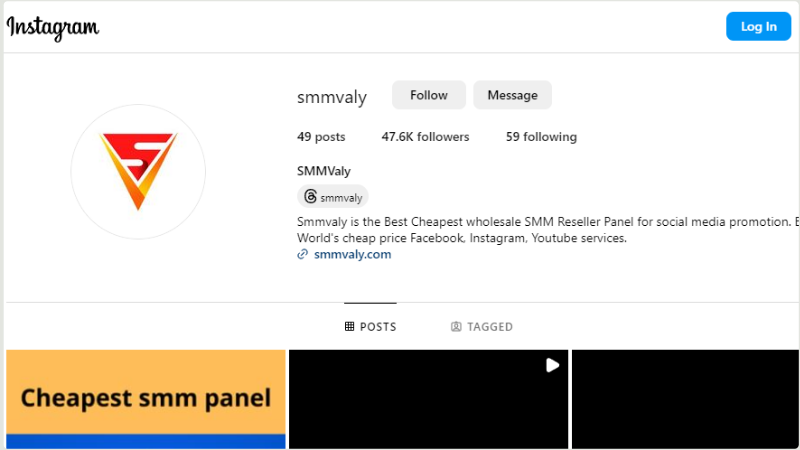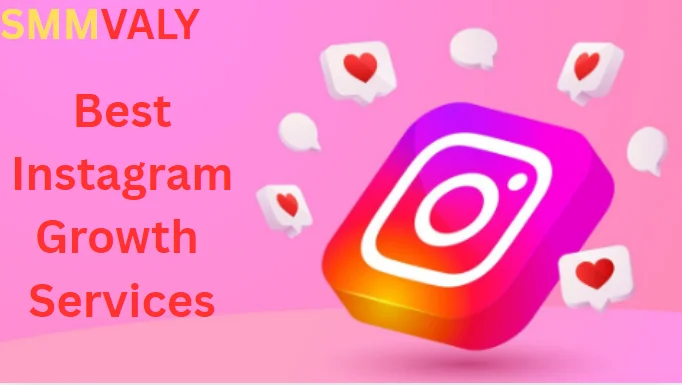BEST SMM PANEL BLOGS
SMMVALY is the best SMM panel service provider on the SMM market. The below blogs will help you to know more about-
Social media marketing
#1 SMM Panel to Buy Canva Pro Lifetime subscription at Wholesale Price

Having the right tools is essential for
creating captivating visuals that leave a lasting impression. Canva Pro stands
out as a powerful design platform, offering a plethora of features tailored for
professionals and enthusiasts alike. However, the cost of a Canva Pro subscription can be a concern
for many.
In this article, we'll explore the benefits
of purchasing Canva Pro at wholesale
prices and introduce you to the best
SMM panel for Canva Pro this purpose - SMMVALY.
What is Canva Pro ?
Canva Pro is a subscription-based service
that unlocks a world of advanced features for individuals and businesses
looking to elevate their design game. With a user-friendly interface and a vast
library of templates, images, and design elements, Canva Pro caters to a
diverse range of design needs. From creating stunning social media graphics to
designing professional presentations, Canva Pro is a go-to tool for those who
demand excellence in their visual content.
Why Buy Canva Pro at Wholesale Price?
In today's competitive digital landscape,
investing in top-tier design tools is crucial for standing out. Canva Pro is
undeniably one of the best platforms for graphic design, but the price can be a
deterrent for many.
Here's why purchasing Canva Pro at wholesale prices is a game-changer:
1. Cost Benefits:
Wholesale prices for Canva Pro
subscriptions translate to significant cost savings. This bulk-buying approach
allows businesses and freelancers to obtain premium design features at a
fraction of the cost they would incur with individual purchases.
2. Accessibility for Businesses and
Freelancers:
Wholesale pricing makes Canva Pro more
accessible to a wider audience. Small businesses, startups, and freelancers can
now harness the full potential of Canva Pro SMM Panel without stretching their budget,
fostering creativity and professionalism in their visual content.
3. Potential Savings:
Emphasizing the potential savings is crucial. Illustrate how opting for wholesale prices can result in substantial monetary benefits over time compared to regular subscription fees. This financial flexibility empowers users to allocate resources more efficiently.
The Best Wholesale SMM Panel for Buying Canva Pro - SMMVALY
When it comes to buying Canva Pro subscriptions at wholesale prices, SMMVALY emerges as the go-to SMM panel.
Here's why SMMVALY stands out:
SMMVALY is a reputable SMM panel that specializes in providing digital products, including Canva Pro subscriptions, at wholesale rates. As a one-stop platform for various online services, SMMVALY has gained trust and recognition in the market.
·
Features that Set SMMVALY Apart:
Highlight the features that make SMMVALY the preferred choice for purchasing Canva Pro. This may include user-friendly interface, quick delivery, secure transactions, and a diverse range of subscription plans to cater to different needs.
·
Reliability and Reputation:
Discuss the track record of SMMVALY in delivering reliable services. Showcase positive reviews and testimonials from satisfied customers who have successfully procured Canva Pro subscriptions through the platform. Emphasize the trustworthiness that comes with choosing SMMVALY.
The combination of Canva Pro's powerful
design capabilities and the cost-effective approach of purchasing through
SMMVALY creates a winning proposition for businesses and freelancers looking to
enhance their visual content without breaking the bank.
Benefits of Using SMMVALY Panel for Buying Canva Pro Account
SMMVALY offers a seamless and secure transaction process, ensuring a
hassle-free experience for users looking to acquire Canva Pro subscriptions.
One of the standout features is the competitive pricing, allowing users to
enjoy significant savings compared to regular subscription fees. Beyond cost
savings, SMMVALY prides itself on prompt delivery, ensuring that users can
access Canva Pro swiftly after completing their purchase.
Customer testimonials and reviews further attest to the reliability and efficiency of SMMVALY. Users appreciate the transparency and authenticity of the platform, making it a trustworthy choice for procuring Canva Pro subscriptions and other digital products.
How to Buy Canva Pro Using SMMVALY?
Navigating the process of purchasing Canva Pro through SMMVALY is a straightforward affair. Here's a step-by-step guide to help you make the most of this cost-effective solution:
·
Visit the SMMVALY Website: Start by
visiting the official SMMVALY website to explore their range of services.
·
Select Canva Pro Subscription: Browse
through the available digital products and select the Canva Pro subscription
that suits your needs.
·
Review and Confirm: Double-check your
selection and proceed to the checkout. Ensure that you review the details of
your purchase before confirming the transaction.
·
Payment: SMMVALY supports various secure
payment methods, making the payment process convenient and safe.
· Receive Confirmation: Once the payment is processed, you will receive a confirmation email with details on how to access your Canva Pro subscription.
Conclusion:
Purchasing Canva Pro at wholesale prices
through SMMVALY is a strategic move
for individuals and businesses seeking to enhance their design capabilities
while optimizing their budget.
The benefits of Canva Pro, coupled with the
cost savings facilitated by SMMVALY, make it a winning combination for anyone
in need of top-tier design tools without breaking the bank. Explore the
possibilities today and unlock the full potential of Canva Pro with SMMVALY's reliable and cost-effective
services.
How can I attract more Indian followers to my Facebook page?

Whether you're a business, influencer, or content creator, attracting more Indian followers is a strategic move. This guide explores actionable strategies and introduces the role of SMMVALY and SMM Panels in acquiring genuine Indian followers.
Understanding the Importance of Indian Followers on Facebook
1. Market Potential:
- India boasts a massive online user base, making it a lucrative market for businesses and influencers.
- Connecting with Indian followers can amplify your content's visibility and engagement.
2. Cultural Relevance:
- Tailoring your content to resonate with Indian culture increases the likelihood of attracting and retaining Indian followers.
Effective Strategies to Attract Indian Followers:
1. Content Localization:
- Translate or create content in regional languages to broaden your appeal.
- Incorporate culturally relevant themes, festivals, and references.
2. Engage with Indian Trends:
- Stay informed about current trends, events, and holidays in India.
- Participate in relevant conversations and leverage popular hashtags.
3. Collaborate with Indian Influencers:
- Partnering with influencers who have a significant Indian following can introduce your page to a broader audience.
4. Run Targeted Facebook Ads:
- Utilize Facebook's advertising features to target specific demographics, including location-based targeting for India.
Introducing SMMVALY: A Trusted Solution for Indian Follower Acquisition
What is SMMVALY?
- SMMVALY is a reputable SMM Panel that facilitates the acquisition of genuine followers, including Indian followers for your Facebook page.
Key Features of SMMVALY:
- Geo-Targeted Followers: SMMVALY allows you to specify the geographic location of your followers, making it an ideal choice for those aiming to attract an Indian audience.
- Organic Growth: The platform prioritizes delivering authentic followers, ensuring sustained engagement and positive interactions.
How to Use SMMVALY to Attract Indian Followers:
- Create an Account:
- Sign up on the SMMVALY platform and navigate to the Facebook services section.
- Select Geo-Targeting:
- Choose the option to target followers based in India.
- Customize Your Order:
- Tailor your order based on your preferences, such as the number of followers and the pace of delivery.
- Complete the Purchase:
- Safely complete the transaction, and watch as your Indian follower count grows organically.
Ensuring Authenticity and Long-Term Engagement:
1. Combine Paid and Organic Strategies:
- Use SMMVALY strategically to kickstart your follower growth, but complement it with organic engagement efforts.
2. Regularly Update Content:
- Maintain a consistent posting schedule to keep your audience engaged.
- Share content that resonates with Indian culture and interests.
3. Respond to Comments and Messages:
- Actively engage with your audience by responding to comments and messages promptly.
- Encourage discussions and create a sense of community on your page.
Building a Strong Presence in the Indian Market
Attracting more Indian followers to your Facebook page involves a combination of cultural understanding, strategic content creation, and leveraging reliable tools like SMMVALY. By implementing the outlined strategies and using SMMVALY responsibly, you position your page for sustained growth and engagement within the vibrant Indian online community.
What is the safest SMM Panel to buy Instagram followers in 2024?

If you're considering the purchase of Instagram followers in 2024, prioritizing safety and authenticity becomes even more crucial. This comprehensive guide will navigate you through the safest SMM Panel options, shedding light on SMMVALY and imparting invaluable tips for a secure and effective purchase.
Understanding the Significance of a Secure SMM Panel
As social media platforms intensify their crackdown on fake engagement, the importance of choosing a secure SMM Panel cannot be overstated. An authentic service not only safeguards your investment but also ensures sustained and genuine growth for your Instagram profile.
SMMVALY: A Deeper Dive into Trustworthiness
What Distinguishes SMMVALY?
SMMVALY distinguishes itself as a reliable SMM Panel through a combination of user-friendly features, competitive pricing, and a steadfast commitment to account safety.
Key Features of SMMVALY:
Genuine Followers: SMMVALY prides itself on delivering authentic, active followers, fostering organic growth for your Instagram profile.
Security Measures: The platform incorporates advanced security protocols, safeguarding your account information and preserving the integrity of your social media presence.
Timely Delivery: With SMMVALY, timely delivery of purchased followers is assured, allowing you to witness tangible results promptly.
Navigating the Landscape: Tips for Safely Purchasing Instagram Followers in 2024
Conduct Thorough Research:
- Explore reviews and testimonials to gauge the reliability and effectiveness of a particular SMM Panel.
- Forums and online communities can provide valuable insights into the user experiences with different platforms.
Evaluate Security Protocols:
- Prioritize SMM Panels that prioritize robust security measures.
- Look for features such as encryption, secure payment gateways, and a clear privacy policy.
Price vs. Quality:
- While cost is a factor, consider it in conjunction with the quality of service.
- Be wary of services that seem too good to be true; authentic engagement often comes at a reasonable price.
Understand Terms of Service:
- Familiarize yourself with the terms and conditions of the SMM Web Panel.
- Pay attention to refund policies, delivery guarantees, and any potential risks associated with the service.
In-Depth Analysis: SMMVALY's Role in Your Instagram Growth Strategy
Customer-Centric Approach:
SMMVALY's commitment to customer satisfaction goes beyond delivering followers. They prioritize building lasting relationships with their clients, offering support and guidance throughout the process.
Customized Packages:
Tailor your Instagram growth strategy with SMMVALY's customizable packages. Whether you're a burgeoning influencer or an established brand, the platform provides options that align with your unique goals.
Analyzing the Results:
Beyond the initial boost in followers, SMMVALY provides analytics tools to track the impact of your social media marketing efforts. Monitor engagement, track follower growth, and make data-driven decisions for future campaigns.
Navigating Potential Challenges: Tips for Mitigating Risks
Gradual Growth Strategies:
- Opt for gradual follower increases to mimic organic growth.
- Sudden spikes in followers can trigger algorithmic scrutiny.
Diversify Engagement:
- Combine purchased followers with organic strategies.
- Regularly engage with your audience through authentic content and interactions.
Conclusion: Safeguarding Your Online Reputation
As you embark on the journey of choosing an SMM Panel to buy Instagram followers in 2024, remember that your online reputation is an invaluable asset. Investing in a secure SMM Panel is not just a transaction; it's a strategic step towards sustainable growth and a positive digital presence.
By adhering to the outlined tips and considering the unique advantages offered by SMMVALY, you position yourself for success in the competitive landscape of social media marketing. In an era where authenticity matters, make informed decisions that align with your long-term goals.
Common Obstacles Encountered When Launching Your Business Online

Launching a business in the online sphere is a promising
venture, yet it is not without its hurdles. This article explores the prevalent
obstacles that entrepreneurs may face when taking their business online,
emphasizing the pivotal role of tools such as SMMVALY, a leading SMM Panel, in
navigating and overcoming these challenges.
What are the obstacles one may face when launching their business online?
1. Establishing a Visible Online Presence:
The digital landscape is crowded, making it challenging for
new businesses to carve out a visible niche. The competition for attention is
fierce, necessitating strategic planning and effective brand differentiation.
SMMVALY's tailored social media solutions prove instrumental in accelerating visibility
and brand recognition.
2. Navigating the Complexity of Social Media Management:
Crafting a successful social media strategy, managing
content calendars, and engaging with audiences present significant challenges.
SMMVALY, operating as an SMM Panel, streamlines social media management,
providing businesses with a tool to enhance visibility and engagement
effectively.
3. Technical Hurdles and Website Optimization:
Technical challenges, ranging from website functionality to
SEO optimization, often pose obstacles during the online launch. Entrepreneurs
must prioritize user-friendly website design and invest in SEO strategies.
SMMVALY complements these efforts by driving traffic through its social media
expertise, contributing to enhanced online visibility.
4. Adapting to Technological Evolution:
The rapid pace of technological evolution poses an ongoing
challenge for businesses online. Staying informed about emerging trends is
imperative. SMMVALY not only provides social media solutions but also assists
businesses in adapting to new technologies, ensuring they remain at the forefront
of industry advancements.
5. Building Customer Trust and Credibility:
Establishing trust and credibility in the online realm is a gradual process. Genuine customer interactions, testimonials, and transparent online practices contribute significantly. SMMVALY facilitates authentic engagement on social media, playing a crucial role in cultivating a positive online reputation.
What is the role of SMM Panel to overcome these Challenges?
An SMM (Social Media Marketing) Panel plays a crucial role
in overcoming various challenges associated with launching a business online.
Here's how an SMM Panel, particularly one like SMMVALY, can contribute to addressing
the obstacles mentioned:
Establishing a Visible Online Presence:
SMM Panels, including SMMVALY, offer targeted social media
solutions to expedite the process of building a visible online presence.
Through strategic social media campaigns, these panels enhance visibility,
increase brand recognition, and reach a wider audience.
Navigating Social Media Management Complexity:
SMMVALY, as an SMM Panel, simplifies social media
management. It provides tools and features to manage content calendars,
schedule posts, and engage with audiences efficiently. The automation
capabilities of SMM Panels streamline processes, saving time and effort for
entrepreneurs.
Addressing E-commerce Security Concerns:
While SMM Panels primarily focus on social media, they
indirectly contribute to building trust and credibility. By enhancing online
visibility and engagement, businesses using SMM Panels can foster a positive
online reputation, which, in turn, contributes to building customer trust.
Technical Hurdles and Website Optimization:
SMMVALY complements efforts related to website optimization
by driving traffic through social media channels. The increased visibility
generated by SMM Panels can positively impact website performance, contributing
to enhanced SEO and a more user-friendly experience.
Adapting to Technological Evolution:
SMMVALY, as a tool for managing social media, can keep
businesses informed about emerging trends and changes in social media
algorithms. This information is valuable for staying ahead in the dynamic
digital landscape and adapting to technological evolution.
Building Customer Trust and Credibility:
SMM Panels aid in fostering authentic engagement on social
media platforms. By providing tools for genuine interaction, content sharing,
and community building, businesses can use SMMVALY to enhance their online
reputation, contributing to increased trust and credibility.
In essence, an SMM Panel serves as a multifaceted tool for
businesses launching online. It streamlines social media management, enhances
visibility, and provides valuable insights for optimizing digital marketing
efforts. While it may not directly address all challenges, it significantly
contributes to creating a strong foundation for a successful online presence.
Conclusion:
Launching a business online is a journey marked by both
excitement and complexity. Entrepreneurs can strategically overcome these
challenges by integrating tools like SMMVALY, a reliable SMM Panel, into their
digital strategy. As businesses navigate the online landscape, successfully
addressing these obstacles becomes a testament to their adaptability and
preparedness for the digital age.
What is the best SMM Panel to buy Indian followers on Instagram and Facebook?

In the dynamic landscape of digital marketing, businesses are continually seeking effective solutions to bolster their social media presence. This comprehensive guide aims to dissect the intricacies of selecting the ideal SMM Panel, with a special focus on SMMVALY. We delve into the role of SMM Panels, spotlighting the unique attributes of SMMVALY and providing a strategic roadmap for acquiring genuine Indian followers on Instagram and Facebook.
Understanding the Strategic Role of SMM Panels:
At the core of successful social media strategies lies the strategic integration of Social Media Marketing (SMM) Panels. These platforms serve as instrumental tools, offering businesses the capability to amplify engagement, enhance visibility, and organically grow their follower base. SMMVALY, as a dedicated SMM Panel, emerges as a pivotal player in this landscape.
Unveiling SMMVALY: A Distinctive SMM Panel for Genuine Growth:
SMMVALY stands out as an industry-leading SMM Panel,
synonymous with efficiency, reliability, and authenticity. This platform serves
as a dynamic solution for businesses looking to not just accrue followers but
to foster meaningful connections with a targeted Indian audience on Instagram
and Facebook.
Key Features of SMMVALY:
1. Precision in Audience Targeting:
SMMVALY excels in providing precisely targeted Indian followers, aligning seamlessly with a business's specific demographic. This ensures that the acquired followers are not mere numbers but individuals genuinely interested in the brand's offerings.
2. Commitment to Authentic Engagement:
In an era where authenticity is paramount, SMMVALY distinguishes itself by steering clear of artificial growth mechanisms. The commitment to genuine engagement ensures sustained, meaningful interactions between businesses and their followers.
3. User-Centric Interface Design:
SMMVALY boasts a user-friendly interface, emphasizing accessibility for businesses of all sizes. The intuitive design streamlines the process of acquiring followers, offering a seamless experience in managing social media growth strategies.
Critical Considerations in Selecting the Optimal SMM Panel:
While SMMVALY shines as an exemplary choice, understanding the broader criteria for selecting the best SMM Panel is imperative. The following factors should be carefully considered:
1. Quality Assurance of Followers:
The paramount consideration is the quality of followers delivered. SMMVALY, in line with the best SMM Panels, ensures that followers are not only authentic but genuinely interested in a business's content.
2. Timeliness in Service Delivery:
In the fast-paced realm of social media, timely delivery is non-negotiable. SMMVALY excels in expediting the process without compromising authenticity, enabling businesses to stay ahead of trends and maintain relevance.
3. Responsive Customer Support:
SMMVALY places a premium on client satisfaction, boasting a responsive and supportive customer service team. This commitment ensures that businesses receive prompt assistance whenever needed, fostering a positive user experience.
Conclusion:
As businesses embark on the quest for enhanced social media presence, the selection of the right SMM Panel becomes a strategic imperative. SMMVALY, with its focus on delivering authentic Indian followers, stands as a frontrunner. The combination of SMMVALY's specialized features and a meticulous consideration of critical factors ensures a seamless and effective social media marketing journey.
In the pursuit of genuine growth on Instagram
and Facebook, businesses can trust SMMVALY as a dedicated ally, elevating their
social presence and fostering meaningful connections in the digital landscape.
Boosting Business Sales through Online Marketing Strategies in 2024

In the ever-evolving landscape of the digital age, the quest to increase business sales has become synonymous with a robust online marketing strategy. As we step into 2024, this article aims to unravel the secrets to success, focusing on leveraging SMMVALY, SMM Panel, and innovative marketing approaches.
Understanding the Power of Online Marketing:
The foundation of a successful business in 2024 lies in its online presence. The journey begins with understanding the transformative power of online marketing. As consumers increasingly turn to digital platforms, businesses must adapt their strategies to meet the demands of a tech-savvy audience.Leveraging SMMVALY for Social Media Success:
SMMVALY, a powerhouse in Social Media Marketing Panel (SMM Panel), has emerged as a game-changer. This tool streamlines social media campaigns, enhancing visibility and engagement. Through case studies, businesses can witness firsthand the impact of integrating SMMVALY into their marketing arsenal.Unveiling the Potential of SMM Panel:
The dynamic realm of online marketing is incomplete without exploring the capabilities of SMM Panel. This tool facilitates efficient social media management and audience engagement. Choosing the right SMM Panel is crucial, and we provide insights into the criteria for selection, ensuring businesses align tools with their unique needs.Strategies to Increase Business Sales:
1. Targeting the Right Audience: Defining and reaching the target audience is paramount. Through advanced online marketing tools, businesses can pinpoint their demographic, leading to more effective campaigns.
2. Content is King: The adage holds true - quality content is the cornerstone of successful online marketing. Crafting compelling, informative, and shareable content is essential for capturing and retaining the interest of potential customers.
3. Embracing Multimedia: Visual content reigns supreme. Videos, infographics, and interactive elements captivate audiences. We explore how businesses can incorporate multimedia for increased engagement and conversion rates.
4. Conversion Optimization: Converting website visitors into customers requires a strategic approach. We delve into proven techniques to optimize conversion rates, transforming casual browsers into loyal customers.
Trends in Online Marketing for 2024:
1. Integration of AI and Machine Learning:
As we enter 2024, the seamless integration of Artificial Intelligence (AI) and Machine Learning (ML) stands out as a pivotal trend in online marketing. Businesses are set to leverage these advanced technologies to enhance customer experiences, refine data analytics, and deliver hyper-personalized content tailored to individual preferences.
2. Rise of Interactive Content:
The digital landscape will witness a paradigm shift towards interactive content. Businesses are gearing up to employ engaging formats such as quizzes, polls, and augmented reality experiences to captivate audiences, fostering deeper connections and memorable online engagements.
3. Optimizing for Voice Search:
Anticipating the prevalence of voice-activated devices, the optimization of content for voice search is emerging as a strategic imperative. Adapting SEO strategies to accommodate conversational queries and providing succinct, relevant responses will be critical for maintaining visibility in search engine results.
4. Emphasis on Sustainability and Social Responsibility:
In the evolving consumer mindset, brands committed to sustainability and social responsibility gain prominence. Marketing strategies in 2024 will reflect these values, with businesses incorporating environmentally conscious practices into their messaging to resonate with socially aware audiences.
5. Continued Dominance of Video Content:
Video content remains the undisputed leader in online marketing. Short-form videos, live streams, and interactive video experiences will define successful strategies. Platforms such as TikTok and Instagram Reels will continue to be instrumental in reaching and engaging target audiences.
6. Evolution of Influencer Marketing:
The landscape of influencer marketing is evolving beyond traditional paradigms. Micro and nano influencers will rise in prominence, and businesses will emphasize cultivating long-term partnerships to foster authentic connections with their target demographic.
7. Augmented Reality (AR) Integration:
Augmented Reality (AR) finds innovative applications in marketing, particularly in industries like retail and fashion. Virtual try-ons and enhanced online shopping experiences are set to redefine customer engagement, offering a novel and immersive approach to brand interaction.
8. Ephemeral Content's Growth Trajectory:
Ephemeral content, characterized by disappearing stories on platforms like Snapchat and Instagram, continues its upward trajectory. Businesses are leveraging the Fear of Missing Out (FOMO) to create urgency and drive heightened engagement in time-sensitive promotions and campaigns.
9. Advancements in Personalization Techniques:
The era of personalization extends beyond basic salutations in emails. Businesses will employ sophisticated personalization techniques, driven by data and AI, to deliver highly tailored content, product recommendations, and personalized experiences that resonate with individual users.
10. Emphasis on Privacy-Centric Marketing:
Acknowledging the growing concerns surrounding data privacy, businesses are prioritizing transparent and ethical data practices. Marketers are actively working towards building trust by providing clear communication on data usage and affording users greater control over their personal information.
Measuring Success:
Key Performance Indicators (KPIs) serve as the compass for online marketing success. Understanding the metrics that matter and utilizing analytics tools empower businesses to assess the effectiveness of their marketing strategies.Conclusion:
In navigating the intricate world of online marketing in 2024, the fusion of SMMVALY, SMM Panel, and strategic marketing approaches emerges as the key to unlocking unprecedented success. By staying informed about industry trends, adopting cutting-edge technologies, and optimizing online strategies, businesses can position themselves as leaders in the digital era. As the online landscape continues to evolve, the businesses that adapt and innovate will undoubtedly thrive, making 2024 a year of unparalleled growth and achievement.A guide to finding the best Instagram growth services | SMMVALY

Instagram is one of the most important marketing channels for businesses, but if we are being completely honest, it's not easy. When you create high-quality content, post and engage regularly, and still struggle to build your presence and gain followers, this slow rate of Instagram growth for a lot of businesses is highly demotivating and takes away time that you can otherwise spend creating more content. So I have some good news for your Instagram services. Use our best Instagram growth services. It can help to build your Instagram audience and reach new leads, and grow your revenue. In this article, we will explore why SMMVALY is considered the best SMM panel and why it offers the best services to grow your Instagram account naturally. Instagram has become one of the most popular Social media platforms. Millions of people use it every day to connect, share and grow their brand. However, an organic Instagram growth service can take a lot of time and effort. That's where, ultimately, the best Instagram growth services come in. These services are designed to help you boost your Instagram presence by increasing your followers, engagement and visibility.These services typically work by targeting your ideal audience based on factors like location, Interests and behavior. This helps you gain followers who are more likely to engage with your posts, which can improve your account ranking on Instagram. One of the main benefits of using the best Instagram growth tool is that it helps you gain real followers. When you buy these services from SMMvaly, your account is targeted to people who are most likely to be interested in your content. When you have real followers, you can interact with your posts to boost your account credibility and Rank on social media. SMMVALY best Instagram growing service helps you increase the discoverability of your content by targeting users who match your niche. This means more people will find your content, and it will lead to more engagement and followers. When your content gets more attention, it is more likely to rank higher in Instagram's recommended posts. This is the best tool to help your account get seen by a larger audience. Top Instagram growth service offers you targeted growth methods, which means your followers are chosen based on specific interests and behaviors. This makes sure that the followers you gain are relevant to your content and more likely to engage with it. With this more engagement, you can get a better chance to rank higher. Organic Instagram growth service can take a lot of time, and without consistency, your account might not see the best results. SMMVALY best Instagram growth services ensure that your account grows steadily and consistently, which helps you rank faster and more effectively. With regular activity and engagement, your account will be more likely and boost your strong presence on social media. It can take months to build a considerable following on Instagram, but with Instagram services help you can boost your presence on the platform by growing your followers. The best is when you use these services; they use organic methods like engaging with your target followers and connecting with influencers. Also buy instagram impression. Having a significant follower base helps to enhance your brand authority and credibility to improve your reputation, and with a strong reputation, you can collect more customer reviews and post them as Instagram reviews to grow your followers. By boosting your followers, the best Instagram growth tool, SMMVALY helps establish you as an expert in your field so you can make more sales and also encounter opportunities for collaborations. Growing your Instagram organically can be a time-consuming process. With the best Instagram growth services, you can easily save your time by automating many of the tasks involved in growing your account, such as following relevant users, liking posts, and engaging with your audience. If you are looking to grow your Instagram account quickly and effectively, buy the best Instagram growth services. These services help you gain real followers, improve engagement, and get your account ranked faster. When you have a business, influencer, or are just looking to grow your personal brand, these services can help you achieve your goals in less time. By using our best Instagram growing service, you can take your account to new heights. It increases your visibility and reaches more people, ultimately helping you rank faster and achieve success as you want. What is an Instagram growth service? This service helps you increase your followers, engagement and visibility on Instagram. Are Instagram growth services safe? Yes, mainly provide the best and safest Instagram growth services. Can Instagram growth services help me rank faster? Yes, it can help you gain real followers, improve engagement and increase your content visibility.What is the best Instagram growth service?
How our best Instagram growth services help you rank faster
Increase in real followers
Better content discovery
Targeted growth
Consistency
Benefits of using the best Instagram growing service
Gain followers organically
Enhance your brand reputation
Save time and effort
Conclusion
FAQs
Monetizing Your Website: A Step-by-Step Guide to Adding Ads with an SMM Panel

Are you looking to turn your website into a revenue-generating powerhouse? Adding ads to your site is a fantastic way to make money from advertisers, and in this comprehensive guide, we'll take you through the process step by step. Whether you're a beginner or a seasoned website owner, these instructions will show you how to seamlessly integrate Google Ads using two popular methods: Google AdSense and the Ezoic display ad network.
1. Prepare Your Website for Ads
Before diving into the world of ads, ensure your website is ready. It must be live, accessible, and filled with quality content. Aim for at least 1,000 words per page, with a prime sidebar location for optimal ad placement.
2. Ensure Compliance for Smooth Ad Approval
To increase your chances of ad approval, adhere to ad network compliance requirements. Avoid offering copyrighted material, counterfeit goods, or unreliable traffic. Stay away from adult, dangerous, or derogatory content, and make sure your site aligns with Google's advertising policies.
3. Apply to an Ad Network: Google AdSense and Ezoic
Choose a reliable ad network like Google AdSense or Ezoic to manage your ad inventory. Google AdSense is excellent for beginners, paying 68% of ad revenue. Ezoic, an alternative, pays a generous 90%. Applying is easy, and you can sign up for AdSense here and Ezoic here.
Benefits of utilizing an SMM panel for effective ad management
Social Media Marketing (SMM) panels offer a range of advantages that can complement and amplify your efforts in managing and optimizing ads on your website.
- Centralized Control and Management: An SMM panel provides a centralized platform for managing various aspects of your ad campaigns. This includes monitoring performance, adjusting settings, and making data-driven decisions.
- Real-time Analytics and Reporting: Gain valuable insights into your ad performance with real-time analytics and reporting. SMM panels often offer detailed data on impressions, clicks, and conversions, allowing you to make informed adjustments to your ad strategy.
- Targeted Advertising: Utilize the targeting capabilities of an SMM panel to reach specific demographics, interests, and behaviors. This precision ensures that your ads are displayed to the most relevant audience, increasing the likelihood of engagement.
- Cost-Effective Campaigns: With detailed analytics, you can identify high-performing ads and allocate your budget more effectively. This data-driven approach helps maximize the impact of your advertising spend, ensuring a better return on investment.
- Automation for Efficiency: SMM panels often come equipped with automation features, streamlining routine tasks and saving time. Automation can include scheduling ad placements, adjusting bids, and implementing changes based on predefined criteria.
- Comprehensive Ad Performance Tracking: Track the performance of your ads across various social media platforms and other channels. This comprehensive tracking allows you to understand which platforms are delivering the best results and adjust your strategy accordingly.
- Enhanced User Engagement: SMM panels may offer features to enhance user engagement, such as interactive ad formats, social sharing options, and feedback mechanisms. Engaged users are more likely to interact with and respond positively to your ads.
- Adaptability to Trends: Stay ahead of the curve by adapting your ad strategy to current trends. SMM panels can provide insights into emerging trends, allowing you to adjust your campaigns to align with what resonates with your target audience.
- Streamlined Communication: If your website collaborates with influencers or external partners for ad placements, an SMM panel can facilitate streamlined communication and collaboration. This ensures that all stakeholders are on the same page regarding campaign objectives and performance.
- Optimized Ad Creatives: Leverage the data provided by SMM panels to optimize your ad creatives. Identify which visuals, copy, and formats are most effective, allowing you to refine your content for maximum impact.
4. Implement Ads on Your Website
Once accepted by an ad network, follow specific steps for implementation. For Google AdSense, add the provided HTML code between the <head></head> tags on your website. For Ezoic, integrate your site with their platform using the provided name servers and follow their setup wizard.
5. Choose Ad Types to Enhance User Experience
Both AdSense and Ezoic allow you to customize ad types and sizes. Tailor your selection to create a seamless and visually appealing experience for your visitors.
6. Adjust Ad Settings for Optimal Performance
Balance revenue and user experience by adjusting ad settings. For Google AdSense, enable features like Auto Ads, In-Page Ads, Multiplex Ads, and more. In Ezoic, optimize goals, adjust ad percentages per device, and explore various ad features for increased revenue.
7. Monitor Ad Performance for Continuous Improvement
Keep a close eye on ad performance over time. Utilize Google AdSense reports or Ezoic's analytics to analyze data related to ad formats, sizes, and locations.
8. Explore Additional Ad Placement Opportunities
Once ads are live on your site, look for ways to increase revenue. Consider adding more ads to each page strategically. Remember, more ads often translate to more revenue.
Maximize your revenue potential by strategically utilizing an SMM panel for additional ad placement
Maximizing your revenue potential is a crucial aspect of successful ad management. By strategically utilizing an SMM panel for additional ad placement, you can enhance your website's monetization strategy and boost overall earnings.
Here's how you can achieve this:
- Diversify Ad Placements: Use the SMM panel to diversify your ad placements across various platforms and channels. This could include popular social media platforms, sponsored content on relevant blogs, or even targeted email campaigns. Diversification increases your reach and potential revenue streams.
- Explore Social Media Advertising: Leverage the power of social media advertising through the SMM panel. Create engaging ad campaigns on platforms like Facebook, Instagram, Twitter, and LinkedIn. These platforms offer highly targeted advertising options to reach specific demographics and interests.
- Collaborate with Influencers: Identify influencers in your niche through the SMM panel and collaborate with them for ad placements. Influencers have a dedicated and engaged audience, providing a valuable opportunity to showcase your ads to a larger and more receptive market.
- Implement Sponsored Content: Utilize the SMM panel to identify opportunities for sponsored content placement. This could involve partnerships with relevant websites, blogs, or online publications where your ads seamlessly integrate with the content, increasing visibility and credibility.
- Optimize Ad Timing: Use the SMM panel to analyze the most effective times for ad placement. Understand the peak times when your target audience is most active, ensuring your ads are strategically placed for maximum visibility and engagement.
- Utilize Ad Retargeting: Implement ad retargeting strategies through the SMM panel. This involves displaying ads to users who have previously visited your website. Retargeting keeps your brand top-of-mind and encourages users to return, increasing the chances of conversion.
- Geo-Targeting for Localized Impact: Leverage geo-targeting features offered by the SMM panel to tailor ad placements based on the location of your audience. Localized ads can be more relevant and appealing, leading to higher engagement and conversion rates.
- Experiment with Different Ad Formats: The SMM panel can help you experiment with various ad formats, including videos, carousel ads, and interactive content. Testing different formats allows you to identify what resonates best with your audience and optimize for higher click-through rates.
- Monitor and Adjust in Real-Time: Use the real-time monitoring capabilities of the SMM panel to track the performance of your additional ad placements. If certain placements are not yielding the desired results, make adjustments promptly to optimize for better outcomes.
- Evaluate ROI and Adjust Budgets: Regularly evaluate the return on investment (ROI) for each ad placement facilitated by the SMM panel. Based on performance, adjust your advertising budgets to allocate resources where they generate the highest revenue.
Strategically utilizing an SMM panel for additional ad placement is a dynamic and ongoing process. By staying informed about emerging trends, analyzing data, and adapting your strategy accordingly, you can continuously optimize your ad placements to maximize revenue potential. Remember, flexibility and a willingness to experiment are key to finding the most effective ad placement strategy for your specific audience and goals.
9. Consider Direct Ad Deals for a Personal Touch
Thinking beyond traditional ad networks? Consider reaching out to advertisers directly for personalized ad deals. While it requires more effort, the potential for higher earnings can be substantial.
10. Keep Privacy Policy Updated for Compliance
Maintaining an updated privacy policy is crucial. Ad networks and companies often require it for compliance. Ensure your policy reflects any direct ad deals and their impact on your visitors.
Follow these steps, explore the benefits of an SMM panel, and continuously optimize for the best results. Your website has the potential to not only engage visitors but also generate substantial revenue through well-placed and carefully managed ads. Good luck on your journey to a more profitable online presence!
What’s the Difference Between SEO, SEM, SMM, and SMO?

In the vast landscape of digital marketing, acronyms like SEO, SEM, SMM, and SMO can be perplexing. As you aim to boost your website's traffic, understanding the intricacies of these strategies becomes pivotal.
This article serves as a guide, unraveling the distinctions between Search Engine Optimization (SEO), Search Engine Marketing (SEM), Social Media Optimization (SMO), and Social Media Marketing (SMM). Let's demystify these terms and explore how each can contribute to your website's success.
SEO: Search Engine Optimization
Defining Organic Visibility
Search Engine Optimization (SEO) is the cornerstone of digital visibility. It involves optimizing your website to rank higher in search engine results pages (SERPs). The primary focus is on organic strategies, emphasizing keyword optimization, high-quality content, and an exceptional user experience. SEO is the foundation upon which successful online presence is built.
To delve deeper, consider the significance of keyword research. Identifying and incorporating relevant keywords into your content ensures that your website is discoverable by search engines. This section will also emphasize the importance of creating compelling, informative content and optimizing technical aspects like meta tags and site speed.
SEM: Search Engine Marketing
Beyond Organic: Embracing Paid Strategies
Search Engine Marketing (SEM) goes beyond organic methods, incorporating paid advertising to boost a website's visibility. At the heart of SEM is Pay-Per-Click (PPC) advertising, a model where advertisers pay a fee each time their ad is clicked. This section will explore the dynamics of PPC, discussing how bidding, ad relevance, and landing page quality influence ad placement and cost.
Moreover, we'll delve into other SEM components, such as display advertising and remarketing. Understanding the synergy between organic and paid strategies will equip you to maximize your website's reach and effectiveness in the competitive digital landscape.
SMO: Social Media Optimization
Crafting a Robust Social Presence
Social Media Optimization (SMO) centers on leveraging social media platforms to enhance brand visibility. This involves optimizing social profiles, sharing engaging content, and encouraging social sharing. The interconnectedness of social media and SEO will be highlighted, showcasing how a strong social presence indirectly contributes to increased visibility and traffic.
Creating shareable content: Creating shareable content is one of the key elements of effective SMO. This means developing content that is not only interesting but also valuable to your target audience. By doing so, you increase the likelihood that your content will be shared by your followers, which in turn can help to increase your brand's visibility and reach.
Optimizing social media profiles: Optimizing your social media profiles is another important element of SMO. This involves making sure that your profiles are complete, up-to-date, and reflective of your brand's image and messaging. By optimizing your profiles, you create a consistent and professional presence across all social media platforms.
Engaging with audience: Engaging with your audience is also crucial for effective SMO. This means responding to comments, messages, and mentions in a timely and respectful manner. By engaging with your audience, you can build relationships, create brand loyalty, and foster a sense of community around your brand.
By mastering SMO, you can tap into the vast potential of social media platforms to amplify your brand message. This can lead to increased brand awareness, engagement, and ultimately, conversions. So, take the time to develop a comprehensive SMO strategy and start reaping the benefits of social media marketing today!
SMM: Social Media Marketing
Proactive Engagement through Paid Channels
Social Media Marketing (SMM) takes a proactive approach, incorporating paid advertising on social media platforms. Beyond organic methods, SMM involves targeted ads to reach specific demographics. We'll explore how SMM complements other marketing efforts and can drive immediate results.
## One of the key components of running successful social media ad campaigns is identifying your target audience. This involves researching and analyzing your current followers and potential customers to determine their demographics, interests, and behaviors. Once you have a clear understanding of your target audience, you can tailor your ad creatives to resonate with them and increase the likelihood of engagement.
## Crafting compelling ad creatives is also crucial to the success of your social media ad campaigns. This involves creating visually appealing graphics or videos that effectively communicate your brand's message and call-to-action. It's important to test different ad formats and messaging to determine what resonates best with your audience.
## Another important aspect of running social media ad campaigns is selecting the right channels to advertise on. Each social media platform offers unique targeting options and ad formats, so it's important to research which channels align with your audience and business goals.
By implementing these strategies and continuously monitoring and optimizing your campaigns, you can effectively leverage the power of social media advertising to drive targeted traffic, increase brand awareness, and ultimately drive sales.
Paid vs Organic Traffic
Understanding the Traffic Landscape
Distinguishing between paid and organic traffic is crucial for crafting an effective digital marketing strategy. Here, we'll draw a clear line between the two, explaining how SEO and SMO primarily generate organic traffic through content and social engagement. On the flip side, SEM and SMM involve strategic investments in advertising to drive targeted traffic.
Understanding the advantages and limitations of each approach will empower you to make informed decisions about allocating your resources. Whether you opt for organic growth or invest in paid channels, a balanced strategy is often the key to sustainable success.
Which Marketing Strategy Is Best For Your Business?
Strategic Decision-Making
It's important to understand the differences between these strategies, so you can make the best decision for your business. SEO (Search Engine Optimization) is all about optimizing your website and content so that it appears higher in search engine results pages (SERPs) for relevant keywords. This is a long-term strategy that requires consistent effort, but the benefits are significant, including increased visibility and traffic to your website.
SMO (Social Media Optimization) involves optimizing your social media profiles and content to increase engagement and drive traffic to your website. This strategy can also help to improve brand awareness and reputation.
SEM (Search Engine Marketing) involves paid advertising to appear at the top of SERPs for specific keywords. This can be an effective way to get quick results and drive traffic to your website, but it can also be expensive.
SMM (Social Media Marketing) involves paid advertising on social media platforms to increase visibility, engagement, and traffic to your website. This can be a great way to reach your target audience and drive conversions.
Ultimately, the choice between these strategies depends on your business goals and available resources. By understanding the differences between them, you can make an informed decision and create a marketing plan that aligns with your objectives.
Conclusion
In the dynamic landscape of digital marketing, understanding the nuances of SEO, SEM, SMO, and SMM is crucial. Each strategy plays a unique role in driving traffic and expanding your online presence. As you navigate these options, remember that a well-rounded approach often yields the best results. Tailor your strategy to align with your goals, and watch as your website gains the visibility it deserves.
How to Grow Your Twitch Audience Fast: Proven Strategies to Get More Viewers

If you're a gamer, creative, or just a fan, you know that Twitch is the place to be. But, as a content creator, we all want to grow our Twitch audience fast, right? Well, do we have a treat for you!
This guide is your one-stop-shop for all the tips and tricks to get those viewers flocking in. From investing in Twitch viewers to cross-platform promotion, we've got you covered!
Invest In Twitch Viewers:
Investing in Twitch viewers is a legitimate and strategic way to kickstart your channel's growth. By purchasing Twitch viewers, you boost your visibility, making your stream more appealing to potential organic viewers.
However, it's crucial to choose reputable services to ensure genuine engagement and compliance with Twitch's policies.
Key Considerations:
- Reputable Providers: Research and select trustworthy services to avoid potential risks.
- Gradual Growth: Consider a gradual increase in viewers to maintain authenticity and avoid suspicion.
Remember, while investing in viewers can give your channel a push, long-term success relies on genuine audience engagement.
Get Discovered On YouTube:
YouTube serves as an excellent platform to complement your Twitch efforts. Creating highlight reels, tutorials, or entertaining snippets from your Twitch streams and sharing them on YouTube can attract a broader audience.
Effective YouTube Strategies:
YouTube is one of the most popular social media platforms in the world, with billions of users and countless hours of video content uploaded every day. If you're looking to make your mark on the platform, it's important to have a solid strategy in place. Here are some tips to help you make the most of your YouTube channel:
- Define your audience: Before you start creating content, it's important to have a clear idea of who you're targeting. Who is your ideal viewer? What problems are they trying to solve? What kind of content do they enjoy?
- Plan your content: Once you know your audience, it's time to plan your content. What topics will you cover? How often will you post? What format will your videos take? Will you feature guests or collaborate with other YouTubers?
- Optimize your videos: To get your videos seen by as many people as possible, you'll need to optimize them for search. This means using relevant keywords in your titles, descriptions, and tags, as well as including eye-catching thumbnails and engaging video content.
- Engage with your audience: YouTube is a social platform, so it's important to engage with your viewers. Respond to comments, ask for feedback, and create a community around your channel.
- Promote your channel: Finally, don't forget to promote your channel outside of YouTube. Share your videos on social media, collaborate with other content creators, and consider paid advertising to reach new viewers.
By following these strategies, you can build a successful YouTube channel and connect with a loyal audience.
Cross Platform Promotion:
Expanding your reach beyond Twitch involves promoting your streams on various platforms. Utilize social media channels, gaming forums, and Discord communities to share your content and engage with potential viewers.
Cross Platform Promotion Tips:
Consistent Branding: Maintain consistent branding across all platforms for easy recognition.
Engagement: Actively participate in discussions and communities related to your content.
Schedule Announcements: Use scheduled posts to announce upcoming streams and events.
Cross-platform promotion enhances your visibility and creates multiple entry points for potential viewers.
Improve Your Stream Quality:
Quality matters on Twitch, and enhancing your stream's production value can significantly impact viewer retention. Invest in a good microphone, webcam, and ensure a stable internet connection for a seamless streaming experience.
Tips for Stream Quality Improvement:
Professional Overlay: Use overlays to enhance the visual appeal of your stream.
Optimal Settings: Adjust stream settings for the best video and audio quality.
Engaging Content: Plan and organize your content to keep viewers entertained.
A visually appealing and well-organized stream is more likely to attract and retain viewers.
Utilize Twitch Drops:
Twitch Drops are a powerful tool to incentivize viewership. Collaborate with game developers or sponsors to offer exclusive in-game rewards or perks to viewers who watch your streams. This not only boosts viewer numbers but also encourages longer watch times.
Effective Twitch Drops Strategy:
Clear Communication: Clearly communicate the Twitch Drops rewards and requirements.
Collaborate Strategically: Partner with game developers or sponsors relevant to your content.
Limited-Time Offers: Create a sense of urgency by offering Twitch Drops for a limited time.
Twitch Drops create a win-win scenario, benefiting both the streamer and the audience.
Increase Engagement:
Engaging with your audience is a fundamental aspect of growing your Twitch viewership. Interact with viewers through chat, ask for their opinions, and create a sense of community around your channel.
Engagement Strategies:
Viewer Interaction: Respond to comments and questions in real-time.
Polls and Q&A Sessions: Conduct polls or dedicated Q&A sessions during streams.
Channel Points: Implement and promote channel point rewards for increased participation.
Building a community around your Twitch channel fosters loyalty and encourages word-of-mouth promotion.
Conclusion:
Growing your Twitch audience fast requires a multifaceted approach that combines strategic investments, cross-platform promotion, and a commitment to quality content. By incorporating these proven strategies – investing in Twitch viewers, leveraging YouTube, promoting across platforms, enhancing stream quality, utilizing Twitch Drops, increasing engagement, and raiding other channels – you can create a robust growth plan for your Twitch channel. Remember, building a dedicated audience takes time, consistency, and genuine connection. Happy streaming!